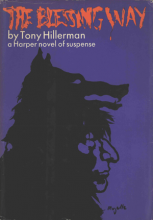Article
In Navajo, another word for "wolf" is "mai-coh," meaning witch. The Navajo fear of wolves derives not from the nature of the animal but rather from the potential for monstrous behavior from humans. Both the Navajo and the Hopi believe that human witches use or possibly abuse the wolf's powers to influence other people. While Europeans warned of a wolf in sheep's clothing, some Native American tribal beliefs cautioned against a human in wolf's clothing. Literally, the Navajo wolf, or witch, can also be referred to as a skinwalker. Not all Navajo witches are skinwalkers, but all skinwalkers are witches.
In some Native American myths, a skinwalker is a person with the supernatural ability to turn into any animal he or she desires. To affect this transformation, legends suggest that skin-walkers need to wear a pelt of the animals they desire to metamorphose into, though this is not always considered necessary. In addition to transforming into animals, the skinwalker has other powers. He or she can read others' minds, control people’s thoughts and behavior, bring forth disease, destroy homes, and even cause death. Trained in both physical medicine for the body and spiritual medicine for the spirit, skinwalkers braid the two practices tightly together, as most skinwalkers at one time served in the position of healer and spiritual guide for their communities. Initiation into the deviant life of a skinwalker mandates breaking the killing taboo and taking the life of a member of the skinwalker's immediate family, usually a sibling.
Dust jacket for first hardback edition of The Blessing Way, published in 1970. Jacket design is by Moselle Thompson. Center for Southwest Research, University of New Mexico.
Manuscripts
A01 The Blessing Way (01-07) p. 21
A01 The Blessing Way (01-07) p. 22
A01 The Blessing Way (01-07) p. 23
A01 The Blessing Way (01-07) p. 24
A01 The Blessing Way (01-07) p. 31
A01 The Blessing Way (01-07) p. 32
A01 The Blessing Way (01-07) p. 35
A01 The Blessing Way (01-07) p. 36
A01 The Blessing Way (01-07) p. 41
A01 The Blessing Way (01-07) p. 42
A01 The Blessing Way (01-07) p. 50
A01 The Blessing Way (01-07) p. 57
A01 The Blessing Way (01-07) p. 61
A01 The Blessing Way (01-07) p. 62
A01 The Blessing Way (01-07) p. 63
A01 The Blessing Way (01-07) p. 69
A01 The Blessing Way (01-07) p. 71
A01 The Blessing Way (01-07) p. 72
A01 The Blessing Way (01-07) p. 89
A01 The Blessing Way (01-07) p. 99
A01 The Blessing Way (01-07) p. 100
A01 The Blessing Way (01-07) p. 101
A01 The Blessing Way (01-07) p. 115
A01 The Blessing Way (01-07) p. 116
A01 The Blessing Way (01-07) p. 117
A01 The Blessing Way (01-07) p. 118
A01 The Blessing Way (01-07) p. 119
A01 The Blessing Way (01-07) p. 121
A01 The Blessing Way (01-07) p. 125
A01 The Blessing Way (01-07) p. 132
A01 The Blessing Way (01-07) p. 161
A01 The Blessing Way (01-07) p. 172
A01 The Blessing Way (01-07) p. 230
A05 Listening Woman (02-13) p. 17
A05 Listening Woman (02-13) p. 18
A05 Listening Woman (02-13) p. 19
A05 Listening Woman (02-13) p. 32
A05 Listening Woman (02-13) p. 70
A05 Listening Woman (02-13) p. 78
A05 Listening Woman (02-13) p. 92
A05 Listening Woman (02-13) p. 93
A05 Listening Woman (02-13) p. 157
References
Kulckhohn, Clyde and Dorothea Leighton
1946 The Navaho. Cambridge: Harvard University Press.
Oshley, Navajo, Robert McPherson, and Barre Tolkein
2000 The Journey of Navajo Oshley: An Autobiography and Life History. Logan: Utah
State University Press.
Shepardson, Mary and Blodwen Hammond
1970 The Navajo Mountain Community: Social Organization and Kinship Terminology.
Berkeley: University of California Press.

